













|
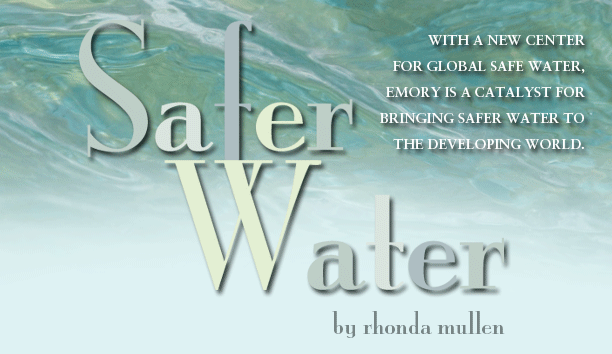 |
 |
 n
1981, the United Nations launched its first decade of safe water
with a lofty goal of “safe water and sanitation for all by
1990.” And indeed for each day from 1981–1990, some
200,000 people gained access to safe drinking water and another
80,000 access to better sanitation. By the decade’s end, more
than 1.2 billion people had been added to the population with improved
water sources and approximately 770 million had benefited from improved
sanitation. n
1981, the United Nations launched its first decade of safe water
with a lofty goal of “safe water and sanitation for all by
1990.” And indeed for each day from 1981–1990, some
200,000 people gained access to safe drinking water and another
80,000 access to better sanitation. By the decade’s end, more
than 1.2 billion people had been added to the population with improved
water sources and approximately 770 million had benefited from improved
sanitation.
But while water and sanitation quality
were improving for some people, other forces intervened to hinder
progress. Population growth and rapid urbanization exceeded the
capacity and infrastructure of developing countries to keep up with
demand for water. Armed conflict and natural disasters 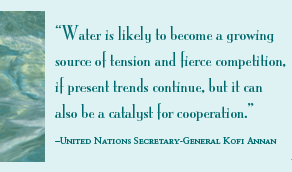 presented
their own logistical problems in providing water and sanitation
to large numbers of displaced people. By the end of the 1990s, despite
the expenditure of $100 billion, the number of people without safe
water and sanitation was the same as at the beginning of the decade.
Today that number remains a staggering 1.1 billion people who are
without this basic human right, or one-sixth of humanity. In addition,
at least 2.4 billion people lack adequate sanitation services. presented
their own logistical problems in providing water and sanitation
to large numbers of displaced people. By the end of the 1990s, despite
the expenditure of $100 billion, the number of people without safe
water and sanitation was the same as at the beginning of the decade.
Today that number remains a staggering 1.1 billion people who are
without this basic human right, or one-sixth of humanity. In addition,
at least 2.4 billion people lack adequate sanitation services.
The public health consequences
of unsafe drinking water and sanitation are severe, particularly
for children. WHO estimates that 6,000 children under the age of
5 die each day of diarrhea, totaling 2 to 3 million every year.
That doesn’t even include the more than 1 billion cases of
respiratory infections and gastroenteritis that are possibly linked
with drinking unsafe water.
The UN recently declared another initiative
to increase access to safe water. The Millennium Development Goal
for Water is to cut in half the proportion of people unable to reach
or afford safe drinking water by 2015. To reach that goal, agencies
working on the problem will have to reach nearly 300,000 people
every day until 2015. And, according to faculty at Emory and CDC,
they’re already behind.

If the challenge of providing safe
water for everyone who lacks it now were easy to solve, we’d
have solved it already, says Jeffrey Koplan, vice president for
academic health affairs at Emory’s Woodruff Health Sciences
Center. But the problem is a complicated one with myriad causes.
In some parts of the world,
geography is the culprit. Water resources may be far away from the
largest concentrations of people. Hot, arid climates bring little
rainfall to some regions. In other areas of the world abundant with
streams, rivers, and lakes, people have access to water, but these
sources may be contaminated. Even if the source is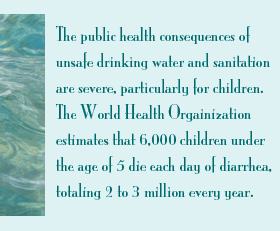 clear, the water can easily become contaminated when transported
in dirty containers, or once it is in the home, when it comes in
contact with unclean hands.
clear, the water can easily become contaminated when transported
in dirty containers, or once it is in the home, when it comes in
contact with unclean hands.
Transporting water from the
source to where it is needed is another element of the challenge,
particularly for women and children, who may travel several hours
a day to haul water home. They get dehydrated coming and going,
caught in a circular pattern. They expend energy and time that could
have been used for education and training.
In addressing the problems that
lead to unsafe water and sanitation, “one size doesn’t
fit all,” says Koplan. “One way to think of the challenge
is to think of lots of different sized feet.”
Recently, Emory has launched
a multi-focal effort to improve safe water, relying on the expertise
of faculty and partners. Or as Koplan says, “Emory has a good-sized
warehouse of high-quality shoes.”
In January, the Rollins School
of Public Health established a Center for Global Safe Water in partnership
with CARE USA, CDC, and Population Services International. With
a mission to improve access to safe drinking water globally, the
center is the focal point for faculty experts in international health,
environmental health, and infectious diseases and the umbrella for
collaborative projects under way around the world. Its three-part
approach is to train graduate and postgraduate students to deal
with the water crisis, to engage in applied public health research
and evaluation, and to strengthen local, in-country partners working
on specific water and sanitation problems and solutions.
The center’s efforts are
bolstered by pledges from Eugene J. Gangarosa, professor emeritus
of International Health, and his wife, Rose Gangarosa, to establish
endowments for two academic chairs: the Eugene J. Gangarosa Chair
in Safe Water and the Rose Salamone Gangarosa Chair in Environmental
Health. Once completed, these endowments, which grow out of Gangarosa’s
lifelong passion for safe water, will help support new faculty in
the center.
The center’s acting director,
Richard Rheingans, sees it as a catalyst for new activities, courses,
and outside collaborations. With support from the Gangarosa Scholarship
Fund, students have a chance to participate in summer fellowships
abroad to strengthen local NGO efforts. Center faculty are pursuing
research on a number of fronts, from stunted growth in Guatemala
to sanitation improvements in El Salvador to an evaluation of safe
and fresh water in Florida. The center’s partnership with
the Atlanta Rotary Club will result in new wells for Kenya along
with support for water treatment and storage. “As you build
a network, you multiply the efforts for safe water and sanitation,”
Rheingans says.
James Hughes believes that,
too. Director of the National Center for Infectious Diseases at
CDC, Hughes will capitalize on the momentum building at the Center
for Global Safe Water when he joins Emory this spring with joint
appointments in public health and medicine and as director of the
Center for Global Safe Water. (See article on page 5.) His plan
for taking the center’s work forward begins with strategic
thinking about how to strengthen existing partnerships across disciplines
and countries. “Microbes don’t respect geographic boundaries.
Therefore, neither does water safety or quality. It is incumbent
on national governments to collaborate,” he says, echoing
the words of Kofi Annan.
Hughes’s priorities include
nurturing innovative ideas from the scientific evidence base and
then communicating those findings to governments and funders for
translation into effective public health action. Communication becomes
a tool for not only changing human behavior but also mobilizing
political will.
|
 |
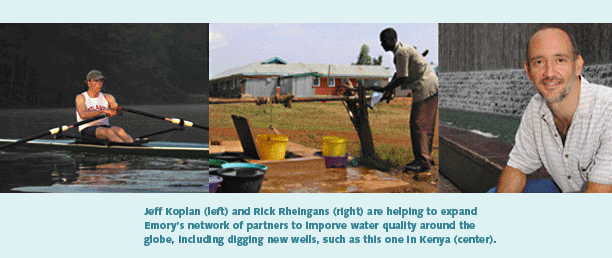 |
 |

 ltimately,
construction of deep wells or piped water systems is the way to
ensure safe water for populations, but that will take time and resources.
Meanwhile, hundreds of millions of people in developing countries
need a solution now. To bridge that gap, CDC and the Pan American
Health Organization developed the Safe Water System (SWS), a simple
and sustainable intervention that uses low-cost technologies appropriate
for distribution in developing nations. The Center for Global Safe
Water is joining other partners to take that intervention to Kenya. ltimately,
construction of deep wells or piped water systems is the way to
ensure safe water for populations, but that will take time and resources.
Meanwhile, hundreds of millions of people in developing countries
need a solution now. To bridge that gap, CDC and the Pan American
Health Organization developed the Safe Water System (SWS), a simple
and sustainable intervention that uses low-cost technologies appropriate
for distribution in developing nations. The Center for Global Safe
Water is joining other partners to take that intervention to Kenya.
At the core of the SWS is a health
focus, which CDC believes is the most critical water issue. Eric
Mintz and Rob Quick, scientists in CDC’s National Center for
Infectious Diseases who have worked on the project since its inception,
are quick to distinguish themselves as “the diarrhea guys,
not the water guys.” In other words, their approach to water
is health-focused rather than a focus on infrastructure.
They began developing the system
in 1991 in response to the seventh pandemic of cholera that swept
across Latin America and continues unabated to this day. As a first
response, Ministries of Health in Latin America recommended boiling
water to treat it and thus kill the deadly cholera bacteria. However,
boiling proved too expensive, time-consuming, and detrimental to
the environment.
Mintz’s and Quick’s
idea was to deliver a point-of-use intervention. It wasn’t
a new idea. For example, at the American University of Beirut (AUB)
in the late 1970s and early 1980s, Gangarosa’s colleague,
Aftim Acra, pioneered a method that used sunlight to purify water.
Research showed the solar technique worked, but people in the developing
world didn’t embrace storing their drinking water in the hot
sunshine, preferring instead the cool places where bacteria breed.
“It was hard for the homemaker to understand that something
invisible in the water was causing the death of a child,”
says Gangarosa.
|
 |
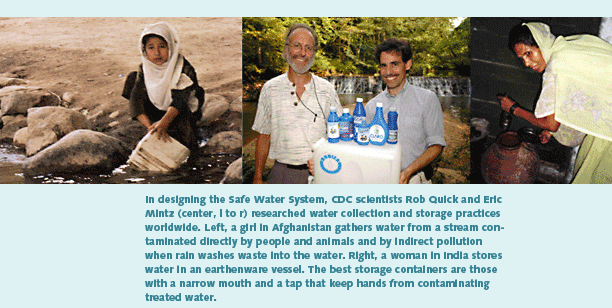 |
 |
Rather than sunlight, Mintz
and Quick settled on the use of dilute chlorine bleach (sodium hypochlorite),
which can be produced cheaply with electricity, salt, and water
as the decontamination strategy. Synthesizing research in Lebanon,
India, Brazil, and Egypt, they assembled an intervention that followed
treatment with safe storage. The storage component required keeping
human hands away from the water, so they held a design competition,
which Gangarosa helped judge, for an appropriate vessel. Although
the storage containers proved too expensive to manufacture, the
competition did help them focus their choice on containers already
on the market that had narrow mouths, lids, and spigots—all
of which kept hands out of the water.
While the chlorine solution
and the storage vessel served as the hardware of the SWS, the more
critical element is what Quick calls the “software.”
He means the messages and methods on which the intervention relies
to change behavior. “We refer to our vessel as the Trojan
Horse,” he says. “Once it’s in the home, it can
lead to other changes in behavior, such as washing hands, washing
fruits and vegetables, and cleaning eating surfaces.”
In Bolivia, where they first
tested the Safe Water System in 1994, the scientists found that
it lowered incidence of diarrhea by 48%. They took the intervention
to other countries, finding a reduction in diarrhea in Uzbekistan
by 85%, in Zambia by 48%, in Guatemala by 25%, in Kenya by 55% in
children under five years old, in Pakistan by 49%, and most recently
in Uganda by 30% in people infected with HIV.
Another valuable finding was that
the intervention is sustainable, a crucial component for long-term
success. By 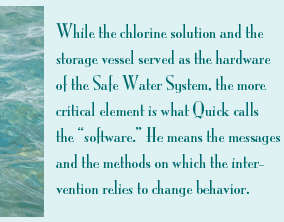 having
local people inexpensively produce the chlorine solution and then
having other locals sell the product, the intervention uses a grass
roots approach to reach the community. Social marketing through
events, commercials, and parades—in collaboration with Center
for Global Safe Water partner Population Services International—raises
awareness and interest in the SWS in local communities and involves
the private sector in distributing the products. In Kenya, the idea
is taken even further as CARE has trained women to sell the hypochlorite
solution and to teach people how to use the intervention. In the
process, the effort is providing a source of badly needed income.
Summer research fellows from the Center for Global Safe Water are
further refining the effort there. (see
related story, Where Health and the Environment Meet) having
local people inexpensively produce the chlorine solution and then
having other locals sell the product, the intervention uses a grass
roots approach to reach the community. Social marketing through
events, commercials, and parades—in collaboration with Center
for Global Safe Water partner Population Services International—raises
awareness and interest in the SWS in local communities and involves
the private sector in distributing the products. In Kenya, the idea
is taken even further as CARE has trained women to sell the hypochlorite
solution and to teach people how to use the intervention. In the
process, the effort is providing a source of badly needed income.
Summer research fellows from the Center for Global Safe Water are
further refining the effort there. (see
related story, Where Health and the Environment Meet)
Since the SWS worked and was
sustainable, Mintz and Quick thought every country would be lining
up to sign on for the intervention. “We thought everyone would
want it,” Mintz says. But, it has taken a decade for the SWS
to be implemented in 19 countries on three continents, and only
in the past few years have the CDC scientists begun to perceive
more general acceptance of point-of-use treatment approaches from
the water community as a whole.
With a combined total of 26
years of their careers devoted to the SWS, Mintz and Quick want
to insure that the Safe Water System continues to reach the people
who need it most. The collaboration with the Center for Global Safe
Water gives them that guarantee. “The center will take the
work into perpetuity,” Quick says. |
 |
| |
|
|
| |
|
|
| |
|
|
| |
|
|
|
|
|
|



